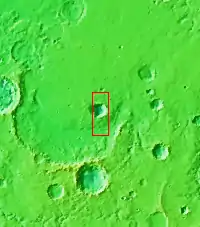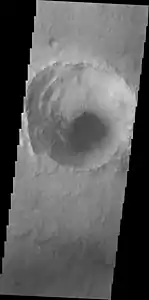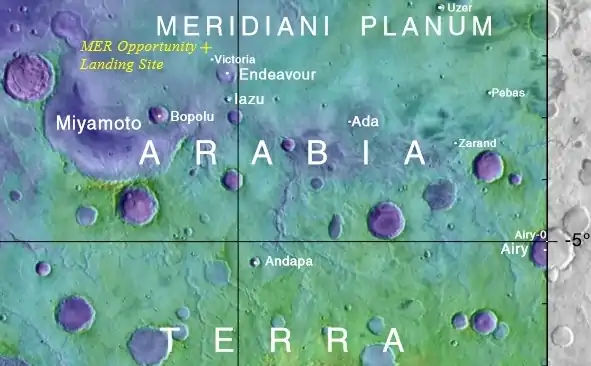Bopolu (crater)
Bopolu is an impact crater located within the Meridiani Planum extraterrestrial plain of Mars.[2] Bopulu was seen by Opportunity rover in 2010 in the distance, and with some of its rim visible.[2] Bopoplu was officially named in 2006 along with 31 Mars craters.[3] Research has indicated that the impact that is thought to have created Bopulu went so deep that it went through existing layers and ejected older material from Mars' Noachian period.[1] Bopulu is a 19 kilometres (12 mi) diameter wide crater south of the Opportunity MER-B landing site, a rover which operated in the region starting in 2004 and therefore resulted in greater exploration and study of craters in this region.[1] Bopulu was identified as a possible source for the Bounce Rock ejecta fragment[1] Bounce rock, which was examined by the MER-B rover, was found to be similar in composition to the shergottite class of Mars meteorite found on Earth (Meteorites found on Earth determined to be from Mars).[1]
 | |
| Planet | Mars |
|---|---|
| Region | Meridiani Planum |
| Diameter | 19 kilometres (12 mi)[1][2] |
Bopulu is said be younger than the Burns Formation that predominates in the area.[4] Bopolu has been studied, along with Tooting crater, to try and better understand the geology of Endeavour crater which MER-B rover reached and could explore in situ.[5]
Bopolu is named for a town in nation of Liberia (see Bopolu, Africa); the name was approved by the IAU in September 2006.[6] Bopolu crater has a feature ID of 14185.[6]
 Color-coded for minerals and annotated, Bopolu crater is centered in this image with its distinctive ejecta detected by MRO's CRISM instrument. Nearby is Endeavour crater, reached by MER-B in 2011
Color-coded for minerals and annotated, Bopolu crater is centered in this image with its distinctive ejecta detected by MRO's CRISM instrument. Nearby is Endeavour crater, reached by MER-B in 2011 The rim of Bopolu crater is visible on the horizon of this March 2010 image taken by the Mars rover Opportunity;Bopolu is 65 kilometers (40 miles) away, when the rover was making its traverse to the closer Endeavour crater.[2]
The rim of Bopolu crater is visible on the horizon of this March 2010 image taken by the Mars rover Opportunity;Bopolu is 65 kilometers (40 miles) away, when the rover was making its traverse to the closer Endeavour crater.[2] A view of Bopolu crater from the THEMIS instrument on 2001 Mars Odyssey[7]
A view of Bopolu crater from the THEMIS instrument on 2001 Mars Odyssey[7]
Context map

See also
- List of craters on Mars
- Geography of Mars
- List of craters on Mars: A-G
- Craters in the area:
- Endeavour (crater) (visited by MER-B)
- Iazu (crater)
- Miyamoto (crater)
- Nearby spacecraft
References
- Opportunity Mars Rover mission: Overview and selected results from Purgatory ripple to traverses to Endeavour crater
- http://www.nasa.gov/mission_pages/mer/images/pia12980.html
- https://astrogeology.usgs.gov/news/nomenclature/names-approved-for-31-craters-on-mars
- "Mars Exploration Rovers Update: Opportunity Tours Spirit of St. Louis Crater". www.planetary.org. Retrieved 2018-02-09.
- The degradational history of Endeavour crater, Mars Archived 2018-02-10 at the Wayback Machine, Icarus, 19 August 2015
- "Planetary Names: Crater, craters: Bopolu on Mars". planetarynames.wr.usgs.gov. Retrieved 2018-02-26.
- http://photojournal.jpl.nasa.gov/catalog/PIA14995